
Click the name of a planet to learn more about its visibility in July 2019: Venus, Jupiter, Saturn, Mars and Mercury.
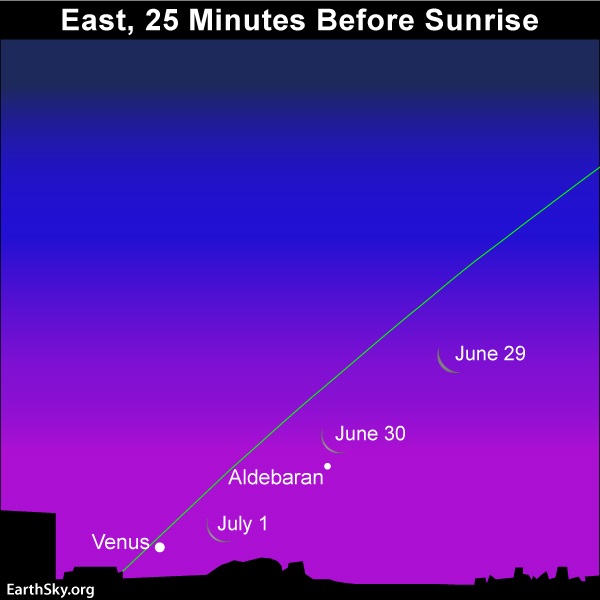
On the morning of July 1 – as seen from around the world – the waning moon is near bright Venus. This very bright planet is also very low in your eastern dawn sky and thus not easy to see. Read more.
Venus, the brightest planet, looms low in the east before sunrise in early July 2019. Day by day, Venus sinks closer to the sunrise, so this world must contend with the sun’s glare throughout this month. However, if you’re in just the right spot in South America, you can watch Venus pop into view during the total eclipse of the sun on July 2, 2019.
In early July, at mid-northern latitudes, Venus rises less than an hour before sunrise. By the month’s end, that’ll taper to about 20 minutes.
At temperate latitudes in the Southern Hemisphere, Venus rises about 50 minutes before sunup in early July. By the month’s end that’ll decrease to about 10 minutes.
In other words – for all of Earth – Venus will disappear from our sky in early July, assuming you’re looking with your eye alone.
What is happening to Venus? Where’s it going? It’s now fleeing ahead of Earth in the race of the planets around the sun. On August 14, 2019, Venus will reach superior conjunction, when it will be behind the sun as seen from Earth. At that point, it’ll transition from the morning to evening sky. Most of us will begin to see Venus as a bright evening “star” in September.
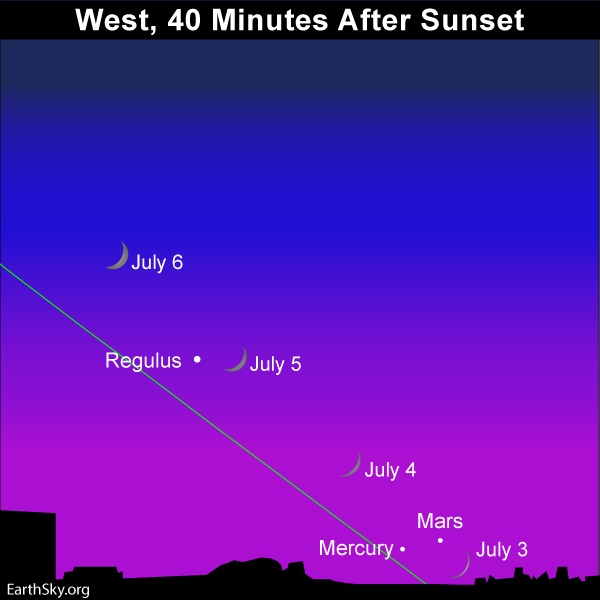
Coming soon! The young evening crescent swings by the planets Mercury and Mars on July 3 and 4, 2019. They’ll be hard to see in the afterglow of sunset; you’ll definitely want your binoculars. Read more.
Mercury starts off the month rather close to Mars on the sky’s dome. Your best chance of catching them is early in the month, when these two worlds are out for a maximum amount of time after sunset. On July 3 and 4, 2019, the young crescent moon will be in the vicinity of Mercury and Mars. But all three celestial bodies – the moon, Mercury and Mars – will have to contend with the glow of sunset, so have binoculars handy.
Click here for recommended sky almanacs providing you with the setting times for Mercury and Mars in your sky.
Day by day, however, these two worlds sink closer to the sunset, with Mercury doing so at a much faster pace than Mars. Mercury moves faster than Mars in orbit, and it moves faster in our sky as well. That’s why the early stargazers named Mercury for their fleet-footed messenger god.
Mercury will meet up with the sun, at inferior conjunction, on July 21, 2019. In the days before and after Mercury’s July 21 conjunction, skilled observers with telescopes will be able to view the planet as a thin crescent world. July 21 will also mark Mercury’s transition out of the evening sky and into the morning sky.
Mars will meet up with the sun, at superior conjunction, on September 2, 2019. For at least six weeks or so on either side of that date, Mars will be absent from our sky, lost in the sun’s glare.
By the way, at this upcoming conjunction, Mercury will swing to the south of the sun’s disk as seen from Earth. But when Mercury reaches its next inferior conjunction on November 11, 2019, the innermost planet will swing directly in front of the sun, to stage a transit of Mercury. Transits of Mercury happen more frequently than transits of Venus; they happen 13 or 14 times per century. The last transit of Mercury happened on May 9, 2016, and – after the one on this upcoming November 11 – the next Mercury transit won’t be until November 13, 2032.

Here’s a superior conjunction. The planet sweeps behind the sun as seen from Earth. Image via COSMOS.
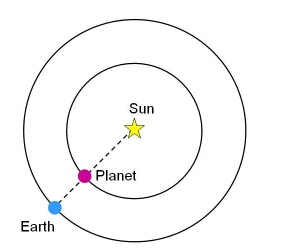
Here’s an inferior conjunction. The planet sweeps between the Earth and sun. As seen from Earth, only Venus and Mercury can have inferior conjunctions. Image via COSMOS.
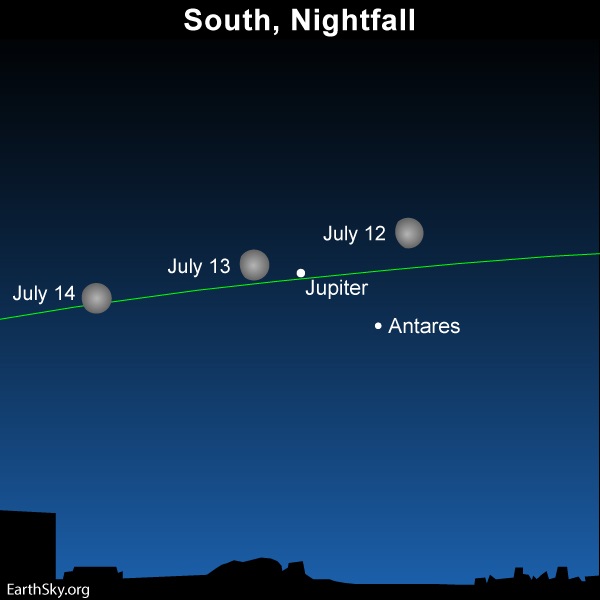
On the evenings of July 12, 13 and 14, 2019, watch for the bright waxing gibbous moon to swing by the giant planet Jupiter. Read more.
Jupiter – the second-brightest planet after Venus – reigns supreme in the July 2019 nighttime sky. Venus is mostly lost in the glare of sunrise throughout July. Jupiter, on the other hand, pops out in the eastern sky at dusk and stays out nearly all night. Jupiter is very bright, brighter than any star. Still not sure? See the moon in Jupiter’s vicinity for several days, centered on or near July 13.
Jupiter’s yearly opposition was June 10, 2019, when this planet lit up the night sky from dusk until dawn. Now, since Jupiter is already in the east when night begins, it doesn’t make it until dawn. From around the world in early July, Jupiter sets about 1 1/2 hours before sunrise (approximate beginning of astronomical twilight). By the end of the month, Jupiter will set beneath the southwest horizon about two hours before the start of astronomical twilight.
Click here to find out when astronomical twilight comes to your sky, remembering to check the astronomical twilight box.
That bright ruddy star rather close to Jupiter on our sky’s dome this year is Antares, the Heart of the Scorpion in the constellation Scorpius. Throughout 2019, Jupiter can be seen to “wander” relative to this zodiac star. In other words, in the first three months of 2019, Jupiter was traveling eastward, away from Antares. But starting on April 10, 2019, Jupiter appeared to reverse course, moving toward Antares. For four months (April 10 to August 11, 2019), Jupiter will be traveling in retrograde (or westward), closing the gap between itself and the star Antares. Midway through this retrograde – on June 10, 2019 – Jupiter reached opposition.
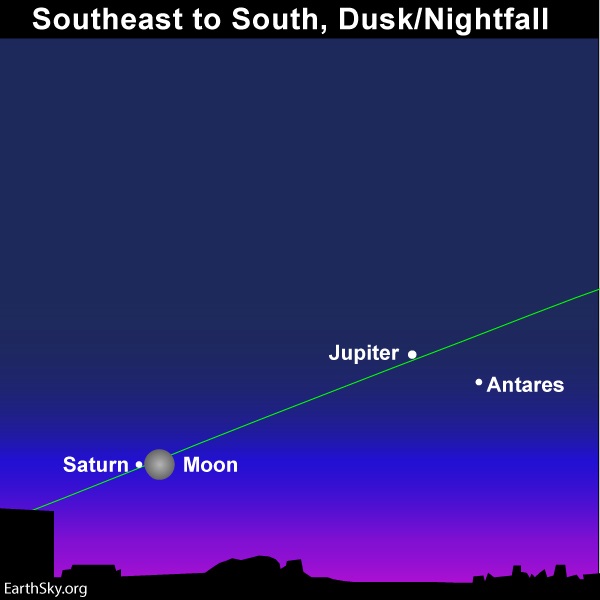
Can’t find Saturn? The almost-full moon pairs up with it as darkness falls on July 15, 2019. Read more.
Saturn reaches opposition on July 9, 2019. At opposition, Saturn rises in the east around sunset, climbs highest up for the night at midnight (midway between sunset and sunrise) and sets in the west around sunrise. Opposition happens when Earth in its orbit swings between the sun and Saturn. Our two worlds are close now, and Saturn, in turn, shines at its brightest best in Earth’s sky.
Watch for the bright moon to couple up with Saturn on or near July 15, as shown on the sky chart above. If you’re in just the right spot in South America, you can actually watch the moon occult (cover over) Saturn on the night of July 15-16, 2019.
Don’t mistake Saturn for the more brilliant planet Jupiter. At nightfall and early evening in July 2019, Saturn shines well below Jupiter and quite close to the southeast horizon. Saturn, although somewhat brighter than a 1st-magnitude star, pales in contrast to the king planet. Jupiter, the fourth-brightest celestial object after the sun, moon and Venus, respectively, outshines Saturn by some 11 times.
In early July 2019, Saturn rises about 1/2 hour after sunset. At opposition on July 9, Saturn rises as the sun sets.
By the month’s end, Saturn comes up roughly 1 1/2 hours before sunset, though the exact figure varies somewhat, depending on your latitude.
Viewing Saturn’s rings soon? Read me 1st
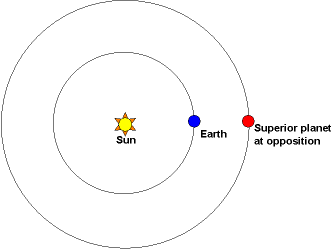
Here’s an opposition. It happens when Earth flies between a planet and the sun. This happens yearly for most of the outer planets (except Mars). Note that the image is not to scale. Saturn is about 9.5 times the Earth’s distance from the sun. Earth goes between the sun and Saturn once a year, 2 weeks later each year. Image via Heavens Above.
What do we mean by bright planet? By bright planet, we mean any solar system planet that is easily visible without an optical aid and that has been watched by our ancestors since time immemorial. In their outward order from the sun, the five bright planets are Mercury, Venus, Mars, Jupiter and Saturn. These planets actually do appear bright in our sky. They are typically as bright as – or brighter than – the brightest stars. Plus, these relatively nearby worlds tend to shine with a steadier light than the distant, twinkling stars. You can spot them, and come to know them as faithful friends, if you try.
Bottom line: In July 2019, two planets – Jupiter and Saturn – are easy to see throughout the month. They both come out at nightfall and are out nearly all night long. Mercury and Mars lurk low in the afterglow of sunset, whereas Venus sits deeply in the glare of morning dawn. Click here for recommended almanacs; they can help you know when the planets rise and set in your sky.
Don’t miss anything. Subscribe to EarthSky News by email
Help EarthSky keep going! Donate now.
Post your planet photos at EarthSky Community Photos
from EarthSky https://ift.tt/1YD00CF

Click the name of a planet to learn more about its visibility in July 2019: Venus, Jupiter, Saturn, Mars and Mercury.

On the morning of July 1 – as seen from around the world – the waning moon is near bright Venus. This very bright planet is also very low in your eastern dawn sky and thus not easy to see. Read more.
Venus, the brightest planet, looms low in the east before sunrise in early July 2019. Day by day, Venus sinks closer to the sunrise, so this world must contend with the sun’s glare throughout this month. However, if you’re in just the right spot in South America, you can watch Venus pop into view during the total eclipse of the sun on July 2, 2019.
In early July, at mid-northern latitudes, Venus rises less than an hour before sunrise. By the month’s end, that’ll taper to about 20 minutes.
At temperate latitudes in the Southern Hemisphere, Venus rises about 50 minutes before sunup in early July. By the month’s end that’ll decrease to about 10 minutes.
In other words – for all of Earth – Venus will disappear from our sky in early July, assuming you’re looking with your eye alone.
What is happening to Venus? Where’s it going? It’s now fleeing ahead of Earth in the race of the planets around the sun. On August 14, 2019, Venus will reach superior conjunction, when it will be behind the sun as seen from Earth. At that point, it’ll transition from the morning to evening sky. Most of us will begin to see Venus as a bright evening “star” in September.

Coming soon! The young evening crescent swings by the planets Mercury and Mars on July 3 and 4, 2019. They’ll be hard to see in the afterglow of sunset; you’ll definitely want your binoculars. Read more.
Mercury starts off the month rather close to Mars on the sky’s dome. Your best chance of catching them is early in the month, when these two worlds are out for a maximum amount of time after sunset. On July 3 and 4, 2019, the young crescent moon will be in the vicinity of Mercury and Mars. But all three celestial bodies – the moon, Mercury and Mars – will have to contend with the glow of sunset, so have binoculars handy.
Click here for recommended sky almanacs providing you with the setting times for Mercury and Mars in your sky.
Day by day, however, these two worlds sink closer to the sunset, with Mercury doing so at a much faster pace than Mars. Mercury moves faster than Mars in orbit, and it moves faster in our sky as well. That’s why the early stargazers named Mercury for their fleet-footed messenger god.
Mercury will meet up with the sun, at inferior conjunction, on July 21, 2019. In the days before and after Mercury’s July 21 conjunction, skilled observers with telescopes will be able to view the planet as a thin crescent world. July 21 will also mark Mercury’s transition out of the evening sky and into the morning sky.
Mars will meet up with the sun, at superior conjunction, on September 2, 2019. For at least six weeks or so on either side of that date, Mars will be absent from our sky, lost in the sun’s glare.
By the way, at this upcoming conjunction, Mercury will swing to the south of the sun’s disk as seen from Earth. But when Mercury reaches its next inferior conjunction on November 11, 2019, the innermost planet will swing directly in front of the sun, to stage a transit of Mercury. Transits of Mercury happen more frequently than transits of Venus; they happen 13 or 14 times per century. The last transit of Mercury happened on May 9, 2016, and – after the one on this upcoming November 11 – the next Mercury transit won’t be until November 13, 2032.

Here’s a superior conjunction. The planet sweeps behind the sun as seen from Earth. Image via COSMOS.

Here’s an inferior conjunction. The planet sweeps between the Earth and sun. As seen from Earth, only Venus and Mercury can have inferior conjunctions. Image via COSMOS.

On the evenings of July 12, 13 and 14, 2019, watch for the bright waxing gibbous moon to swing by the giant planet Jupiter. Read more.
Jupiter – the second-brightest planet after Venus – reigns supreme in the July 2019 nighttime sky. Venus is mostly lost in the glare of sunrise throughout July. Jupiter, on the other hand, pops out in the eastern sky at dusk and stays out nearly all night. Jupiter is very bright, brighter than any star. Still not sure? See the moon in Jupiter’s vicinity for several days, centered on or near July 13.
Jupiter’s yearly opposition was June 10, 2019, when this planet lit up the night sky from dusk until dawn. Now, since Jupiter is already in the east when night begins, it doesn’t make it until dawn. From around the world in early July, Jupiter sets about 1 1/2 hours before sunrise (approximate beginning of astronomical twilight). By the end of the month, Jupiter will set beneath the southwest horizon about two hours before the start of astronomical twilight.
Click here to find out when astronomical twilight comes to your sky, remembering to check the astronomical twilight box.
That bright ruddy star rather close to Jupiter on our sky’s dome this year is Antares, the Heart of the Scorpion in the constellation Scorpius. Throughout 2019, Jupiter can be seen to “wander” relative to this zodiac star. In other words, in the first three months of 2019, Jupiter was traveling eastward, away from Antares. But starting on April 10, 2019, Jupiter appeared to reverse course, moving toward Antares. For four months (April 10 to August 11, 2019), Jupiter will be traveling in retrograde (or westward), closing the gap between itself and the star Antares. Midway through this retrograde – on June 10, 2019 – Jupiter reached opposition.

Can’t find Saturn? The almost-full moon pairs up with it as darkness falls on July 15, 2019. Read more.
Saturn reaches opposition on July 9, 2019. At opposition, Saturn rises in the east around sunset, climbs highest up for the night at midnight (midway between sunset and sunrise) and sets in the west around sunrise. Opposition happens when Earth in its orbit swings between the sun and Saturn. Our two worlds are close now, and Saturn, in turn, shines at its brightest best in Earth’s sky.
Watch for the bright moon to couple up with Saturn on or near July 15, as shown on the sky chart above. If you’re in just the right spot in South America, you can actually watch the moon occult (cover over) Saturn on the night of July 15-16, 2019.
Don’t mistake Saturn for the more brilliant planet Jupiter. At nightfall and early evening in July 2019, Saturn shines well below Jupiter and quite close to the southeast horizon. Saturn, although somewhat brighter than a 1st-magnitude star, pales in contrast to the king planet. Jupiter, the fourth-brightest celestial object after the sun, moon and Venus, respectively, outshines Saturn by some 11 times.
In early July 2019, Saturn rises about 1/2 hour after sunset. At opposition on July 9, Saturn rises as the sun sets.
By the month’s end, Saturn comes up roughly 1 1/2 hours before sunset, though the exact figure varies somewhat, depending on your latitude.
Viewing Saturn’s rings soon? Read me 1st

Here’s an opposition. It happens when Earth flies between a planet and the sun. This happens yearly for most of the outer planets (except Mars). Note that the image is not to scale. Saturn is about 9.5 times the Earth’s distance from the sun. Earth goes between the sun and Saturn once a year, 2 weeks later each year. Image via Heavens Above.
What do we mean by bright planet? By bright planet, we mean any solar system planet that is easily visible without an optical aid and that has been watched by our ancestors since time immemorial. In their outward order from the sun, the five bright planets are Mercury, Venus, Mars, Jupiter and Saturn. These planets actually do appear bright in our sky. They are typically as bright as – or brighter than – the brightest stars. Plus, these relatively nearby worlds tend to shine with a steadier light than the distant, twinkling stars. You can spot them, and come to know them as faithful friends, if you try.
Bottom line: In July 2019, two planets – Jupiter and Saturn – are easy to see throughout the month. They both come out at nightfall and are out nearly all night long. Mercury and Mars lurk low in the afterglow of sunset, whereas Venus sits deeply in the glare of morning dawn. Click here for recommended almanacs; they can help you know when the planets rise and set in your sky.
Don’t miss anything. Subscribe to EarthSky News by email
Help EarthSky keep going! Donate now.
Post your planet photos at EarthSky Community Photos
from EarthSky https://ift.tt/1YD00CF

Aucun commentaire:
Enregistrer un commentaire